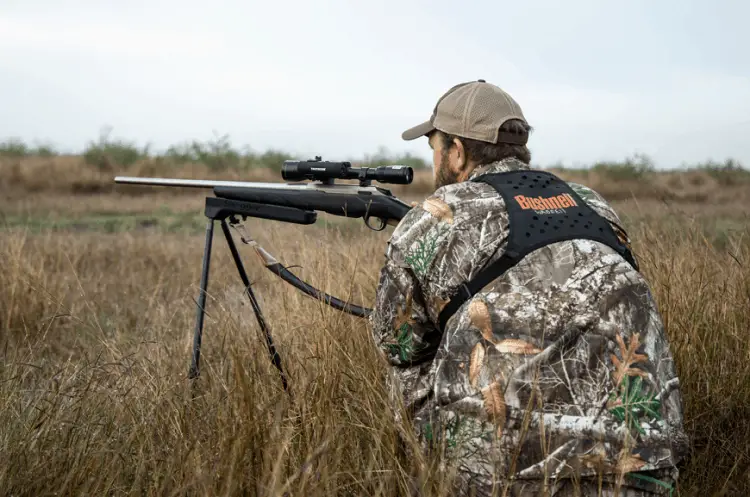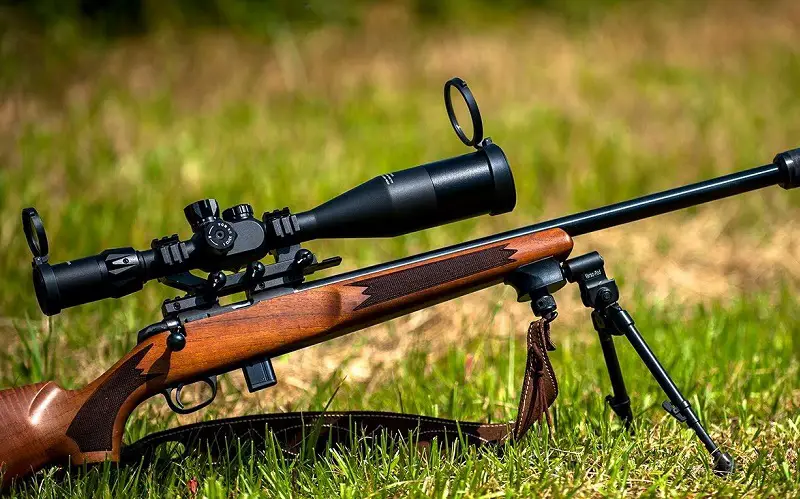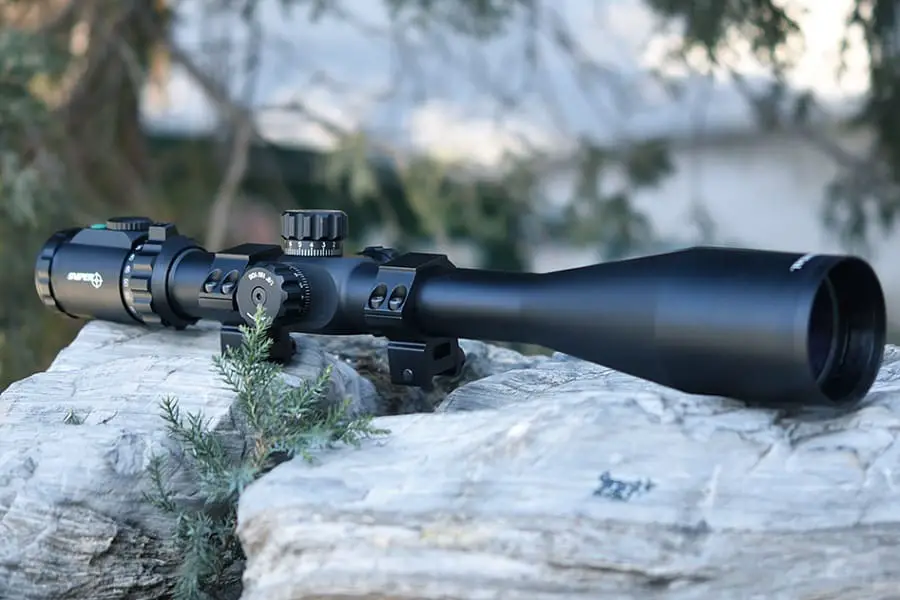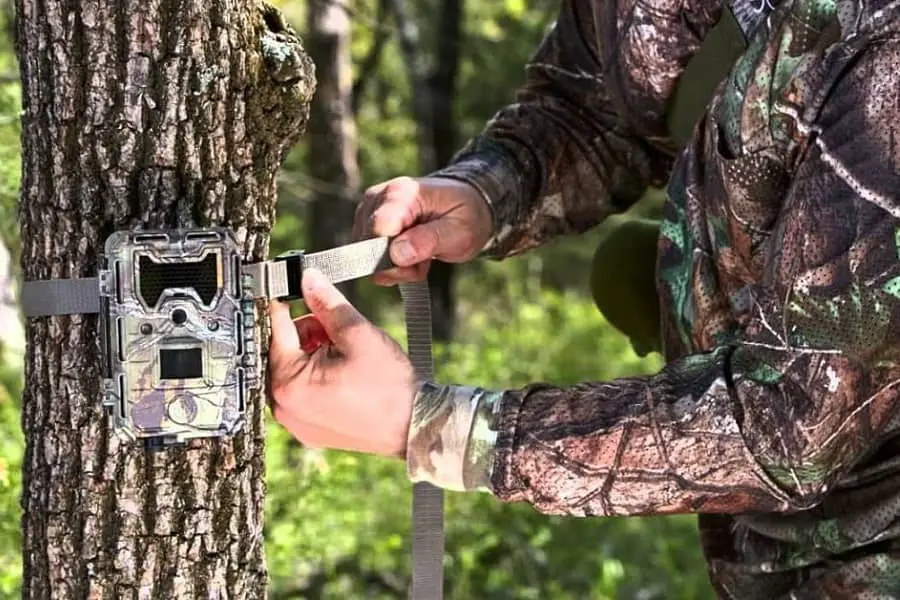The question of what is the best rifle scope and its benefits is quite common.
With the growing trend of average citizens taking up the sport of shooting, there are more and more people looking to fully understand what options are available to them and whether or not they will find them useful or desirable.
The answer to this question depends on what your particular shooting goals happen to be.
Here’s Our Top Pick
Vortex Optics Crossfire II
- The 4-12x44 Crossfire II riflescope is one of many configurations in...
- With long eye relief and an ultra-forgiving eye box, you'll be able to...
- Anti-reflective, fully multi-coated lenses provide bright and clear...
Why is it better?
- 4-12x44mm variable optical zoom feature
- High-density aluminum construction for long-term durability
- Waterproof and fog proof design + coated lens
5 Best Rifle Scopes Under $200
With that in mind, let’s now take a closer look at our top picks.



![Best Rifle Scopes for Optimal Performance: From Beginner to Pro 8 [Update] Feyachi 8-32x50 AOEG Scope Dual Red & Green Illuminated Optics Weaver/P-i-c-a-t-i-n-n-y Scope](https://m.media-amazon.com/images/I/51KYe4I85OL._SL160_.jpg)

Let’s dive into the specifics and review each rifle scope individually. You can use the list below to jump and review specific models, or you can read along and go through all the information.
Vortex Optics Crossfire II Rifle Scope
- The 4-12x44 Crossfire II riflescope is one of many configurations in...
- With long eye relief and an ultra-forgiving eye box, you'll be able to...
- Anti-reflective, fully multi-coated lenses provide bright and clear...
Vortex makes some of the best optics out there. You’ll see their name littered across my guides on spotting scopes and monoculars as well.
They just know how to make a superior scope, and Crossfire II is a testament to that. Built with high-density aluminum, they’re able to seal in a perfect O-ring to keep water, moisture, and fog at bay.
If you own any optics, you’ve probably seen countless warnings about the damage that moisture can cause. This is a big up. But what really makes a scope is the lens and how it zooms.
With an anti-reflective coating on their coated lens, you get better light emission and a richer, sharper image every single time.
Your prism helps dictate the scal;e of colors that you can see, and with this, it’s like adding high definition to the naked eye.
With a 4-12x variable zoom function, this is the perfect scope for all levels of engagement while hunting. Personally, I”m a bit fan of the reticle they chose for this, the Dead-Hold BDC, which is simple and effective.
Set your MOA clicks to zero after you sight in, and enjoy the rapid installation process. This could be the last rifle scope you ever love.
Pros
- 4-12x44mm variable optical zoom feature
- High density aluminum construction for long-term durability
- Waterproof and fogproof design + coated lens
- Great vision clarity
- Excellent adjustability
Cons
- Doesn’t come with mount or rings
Features
- Lifetime warranty
- Relatively cheap price
Product Information
- Dimensions: 14.4 x 3.1 x 2.6 inches
- Objective Lens: 44mm
- Zoom: 4x – 12x
- Reticle: Dead-Hold BDC
Nikon Buckmasters II Rifle Scope
Nikon’s take on the classic hunting scope is a close second. They price this fairly while keeping a quality level that only Nikon really can.
Using multi-coated lenses for both the objective and eye side, you’re able to get a clear image that’s as rich in color as the naked eye.
That’s a big deal because there are far too many optics (like cheap department store binoculars, for example) that seem to dampen the color depth that comes through the prism.
You’ll see your target clear as day, and you won’t endure the normal eye strain that comes from sighting in for too long. Scopes trick the human eye, and focusing on them for too long can give you a tension headache.
Nikon uses a rounded lens to help reduce eye strain, and focuses in faster so you don’t have to spend as much time behind the scope.
The only aggravating thing about this scope is that the caps come on the same string, and personally, I prefer to have my caps separated for easier storage.
Pros
- Multi coated lenses provide better imagery
- Positive click adjustments make sighting in a breeze
- Eye relief system reduces strain and risk of headaches
- Fully multi coated optics
- Good price
Cons
- Some blurred images at close or mid-range
Features
- Weatherproof
- Excellent warranty
Product Information
- Dimensions: 19.2 x 4 x 4.5 inches
- Objective Lens: 44mm
- Zoom: 4x – 12x
- Reticle: Nikon’s BDC
UTG 3-9X32 Rifle Scope
- Built on True Strength Platform, Completely Sealed and Nitrogen...
- 1 Inch Tube with Emerald Coating for Maximum Light Transmission,...
- Range Estimating Mil-dot Reticle for Optimal Aiming and Shooting...
It’s all about the lenses. Doesn’t matter if the exterior is made from aluminum or plastic, as long as the lens is sealed and good to go.
In this case, UTG used a complete nitrogen sealing system to keep moisture out of the len and prisms. That’s basically the best thing you can do to protect your lenses, along with what they coated them with.
Emerald coating—that’s what’s on these lenses, and it not only helps with anti-reflective properties (though it isn’t perfect in this department), but it also aids with light transmission through all that nitrogen.
When it comes to the reticle, I think you’ll agree that it’s pretty intense.
Their mil-dot reticle adjusts perfectly as you change your dials from short-range to long-range, so you’re able to adjust to a new yardage fairly quickly, even if you’re not too keen on doing it yourself.
Mix that with the shockproof and fogproof elements to it, and you’ve got one tough-as-nails scope on your hands.
Pros
- Emerald-coated lens prevents reflection and repels water
- Mil-dot reticle accurately changes from short-range to long-range
- Nitrogen-filled for shockproof and fogproof design
- Zero-rest/lockable turrets
- Swat illumination
Cons
- Quality control issues
Features
- TS platform
- Included rings
Product Information
- Dimensions: 9.8 x 3.4 x 3.9 inches
- Objective Lens: 32mm
- Zoom: 3x – 9x
- Reticle: Mil-dot Reticle
Feyachi Tactical Rifle Scope
- The 8-32x50AOEG Scope wide range of magnification gives the user the...
- This scope has an etched-glass reticle, which is superior to a wire...
- This scope features a Mil Dot reticle that can be illuminated in red...
Nothing is better than when you buy something that needs to be assembled, and it gives you the tools to assemble it.
Feyachi includes their adjustment tool along with spare parts and lens caps in their kit, so you get everything you need right from the get go. On top of that, everything you see is shockproof, waterproof, and fogproof.
You’ll hear me talk about how important fog proofing is all across this site. While that’s all well and good, I want to talk about their adjustment system.
The tool works well, but the adjustments can take a bit of fine-tuning to get accurate. That’s one of the things about variable zoom scopes. They’re useful, they can take the place of two separate fixed scope ranges, but there’s always a catch.
Lock in anywhere from 8x to 32x magnification with this 50mm lens, and utilize the drop shot markings in your reticle to accurately align your bullet without having to adjust your entire scope.
If you use a laser rangefinder and determine that an elk you’ve been hunting is an extra 80 yards away, just use the reticle and adjust accordingly. You’ve got this.
Pros
- Shockproof, fog proof, and waterproof
- Includes caps, spare parts and adjustment tool with purchase
- 8-32 x 50mm optical zoom
- Illumination is bright
- Great value for the money
Cons
- It’s not really 32x magnification
Features
- Sun shade
- Very good glass clarity
Product Information
- Dimensions: 14.4 x 3.1 x 2.6 inches
- Objective Lens: 44mm
- Zoom: 4x – 12x
- Reticle: Dead-Hold BDC
CVLIFE Hunting Rifle Scope
- Magnification: 6-24x
- Objective Diameter: 50mm
- Field Of View: 28 ft @ 100 yards
Scopes zoom in for you, and with that, your field of view changes.
The naked eye has about a 135° FOV without the aid of optics, so the farther away you have to look, the more narrow your FOV is.
There’s nothing we can do to physically see over that number. Problem is, when you zoom in a lot, your FOV drastically reduces. That can make scanning a chore.
CVLIFE gives you a wide but plentiful range of magnification, from 6x to 24x, while maintaining a 28-foot-wide FOV at 100 yards zoomed in.
That’s an excellent feature, but one of the best has to be the illuminated reticle. Choose from red or green, let it light up your life and lock onto your target more easily.
If your target is farther away than you expected, use the drop shot lines in your sight to take them down easily.
Altogether, it’s a quality sight, but I do wish it were a bit smoother and more compact up top. You can adjust it in many different ways, but the bulky look can sometimes get in the way.
Pros
- Comfortable 6-24x50mm optical zoom
- Illuminated reticle for better visibility in all environments
- Wide field of view at long ranges
- Built-in laser sight
- Includes 2 types of mounts
Cons
- Reticle issues
Features
- Price
- Eye relief of 3.52 inches
Product Information
- Dimensions: 17 x 3.1 x 3.1 inches
- Objective Lens: 50mm
- Zoom: 6x – 24x
- Reticle: Red and Green Illuminated
Things You Need To Consider

The first part is to understand what is a rifle scope exactly. In layman’s terms, it is a magnifying device that allows you to see targets from a long distance, which would be very difficult to hit using the naked eye.
Design
The design of these scopes is actually based off the technology used in telescopes. As with telescopes, the power of magnification varies a great deal. The particular strength of the scope is typically directly related to its cost.
Unlike most telescopes, however, a scope typically has a graphic inside the viewing area. This is set up so that by viewing through the scope you can align the crosshairs to the intended target.
The graphic can vary to some degree, but will surely involve intersecting lines that create a single focal point.
Mount
The scope is mounted onto the rifle so that when one goes to shoot the rifle they can look into the scope and line up the shot. Proper alignment of the scope to the gun is essential for accuracy.
Many people prefer to have a professional mount the scope for them. Accurate mounting usually requires that the gun is tested in a controlled setting to ensure that it is in proper alignment.
If the scope is not properly mounted you will quickly find that making long distance shots in nearly impossible.
Assistance
It can be somewhat challenging if you are not an expert in scopes to decide which one you would like for your rifle.
Many people choose to seek the assistance of a salesperson or experienced shooter when making the decision of which scope to purchase. Most gun enthusiasts and sellers are more than happy to assist in this process.
One important aspect of magnification is to understand that the higher the magnification is, the smaller the area will be that you will be able to see in your scope. This means that it may take more time to locate your intended target.
Magnification
You will also find that the higher the magnification the lower the amount of light that will enter the scope. This will make objects in view darker and less resolute.
There are pros and cons to each option. To counter this there are scopes that have the ability to adjust the magnification.
To be sure that you are making the best choice for your shooting needs it is best to consult someone that has experience in the type of shooting that you hope to do.
Of course, you can take the time to learn, but having assistance is always beneficial. With time you will gain the knowledge that those that came before you possess.
Rifle Scope FAQ

HOW DOES A RIFLE SCOPE WORK?
Through the prism, or objective lens. Light needs to be allowed to enter (through the glass lens on the opposite end of where you look), while the ocular lens towards the rear or input side of the scope filters that light in a different way.
The ocular lens allows the naked human eye to differentiate this change in light, hence seeing farther away. Your scope helps your actual shot out of the barrel align with what you’re seeing, so once you line it up properly, you can land your shots.
Scopes need light to operate effectively. Scopes also have different magnification levels, known as a variable lens, which can alter the prism’s alignment ever so slightly to help you see at different distances.
WHAT KIND OF SCOPE DO I NEED FOR OVER 200 YARDS?
A 9x40mm scope should work perfectly well up to 200 yards, so a 9x50mm scope will be better suited for over 200 yards. These scopes have bigger prisms that are better suited for long-range distances and shooting.
It’s the same principle that works with spotting scopes and binoculars. The larger the prism, the farther away you can see. This is an instance where size matters, otherwise we’d have pocket-sized telescopes that could inspect the stars.
Think about every telescope you’ve ever seen and how big they are.
WHAT KIND OF SCOPE IS BEST FOR HUNTING?
Generally, an ACOG scope with a variable zoom is your best bet for hunting. For military use, they have intel about an enemy’s placement, but you’re going to stumble upon an animal that isn’t specifically in one location for any reason.
You can’t properly anticipate how far away they are from you. An ACOG with variable zoom will give you enough to work with. You can adapt to short and long-range targets with proper tracking, giving you a more versatile scope experience.
Most rifles will be perfectly okay with an ACOG, but since they are most commonly used with assault rifles, it’s important to check out the dimensions and make sure everything will fit properly before sinking your money into a new ACOG.
WHAT SCOPE DO ARMY SNIPERS USE?
Standard military use is 553 EOTech or the M68 CCO, which can span from short-range to medium-range. Sniper scopes are commonly either a Leupold Mark 4 model or Schmidt & Bender PMII.
Thing is, that’s overkill for civilian uses that focus around hunting and prepping. The scopes that we’ve outlined in this buying guide will be more than enough for civilian use.
One common theme you will see is that manufactures try to emulate military-grade hardware, like sniper scopes, but make them more suited for civilian use, so you still get that tactical look and feel that you’re after.






